Shukui Ren
Masked Multi-Domain Network: Multi-Type and Multi-Scenario Conversion Rate Prediction with a Single Model
Mar 26, 2024Abstract:In real-world advertising systems, conversions have different types in nature and ads can be shown in different display scenarios, both of which highly impact the actual conversion rate (CVR). This results in the multi-type and multi-scenario CVR prediction problem. A desired model for this problem should satisfy the following requirements: 1) Accuracy: the model should achieve fine-grained accuracy with respect to any conversion type in any display scenario. 2) Scalability: the model parameter size should be affordable. 3) Convenience: the model should not require a large amount of effort in data partitioning, subset processing and separate storage. Existing approaches cannot simultaneously satisfy these requirements. For example, building a separate model for each (conversion type, display scenario) pair is neither scalable nor convenient. Building a unified model trained on all the data with conversion type and display scenario included as two features is not accurate enough. In this paper, we propose the Masked Multi-domain Network (MMN) to solve this problem. To achieve the accuracy requirement, we model domain-specific parameters and propose a dynamically weighted loss to account for the loss scale imbalance issue within each mini-batch. To achieve the scalability requirement, we propose a parameter sharing and composition strategy to reduce model parameters from a product space to a sum space. To achieve the convenience requirement, we propose an auto-masking strategy which can take mixed data from all the domains as input. It avoids the overhead caused by data partitioning, individual processing and separate storage. Both offline and online experimental results validate the superiority of MMN for multi-type and multi-scenario CVR prediction. MMN is now the serving model for real-time CVR prediction in UC Toutiao.
Learning Graph Meta Embeddings for Cold-Start Ads in Click-Through Rate Prediction
May 19, 2021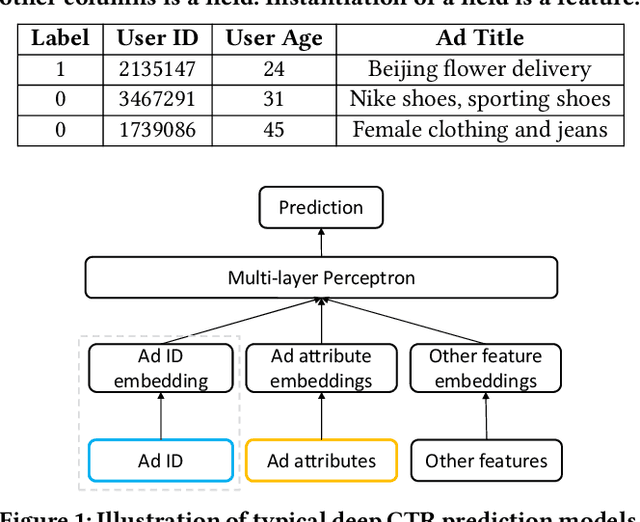
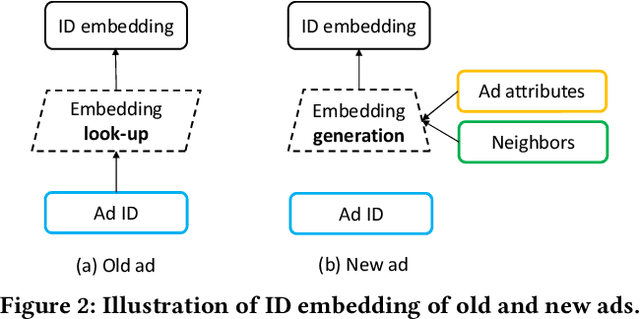
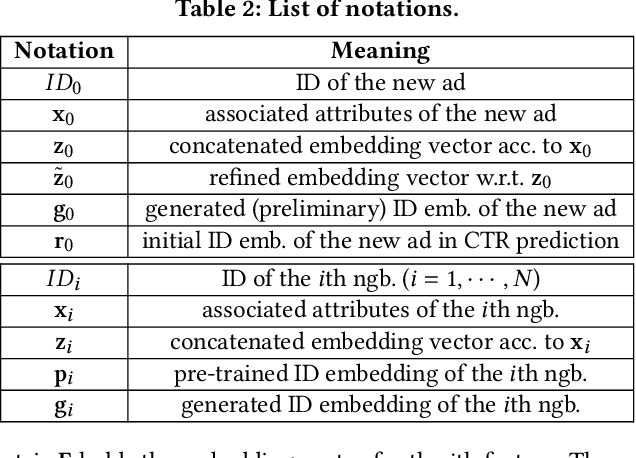
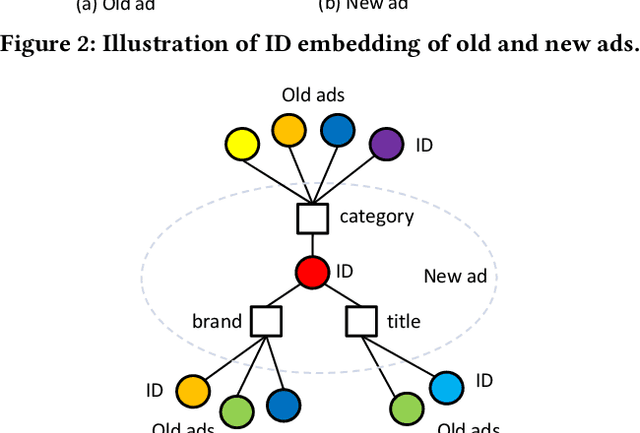
Abstract:Click-through rate (CTR) prediction is one of the most central tasks in online advertising systems. Recent deep learning-based models that exploit feature embedding and high-order data nonlinearity have shown dramatic successes in CTR prediction. However, these models work poorly on cold-start ads with new IDs, whose embeddings are not well learned yet. In this paper, we propose Graph Meta Embedding (GME) models that can rapidly learn how to generate desirable initial embeddings for new ad IDs based on graph neural networks and meta learning. Previous works address this problem from the new ad itself, but ignore possibly useful information contained in existing old ads. In contrast, GMEs simultaneously consider two information sources: the new ad and existing old ads. For the new ad, GMEs exploit its associated attributes. For existing old ads, GMEs first build a graph to connect them with new ads, and then adaptively distill useful information. We propose three specific GMEs from different perspectives to explore what kind of information to use and how to distill information. In particular, GME-P uses Pre-trained neighbor ID embeddings, GME-G uses Generated neighbor ID embeddings and GME-A uses neighbor Attributes. Experimental results on three real-world datasets show that GMEs can significantly improve the prediction performance in both cold-start (i.e., no training data is available) and warm-up (i.e., a small number of training samples are collected) scenarios over five major deep learning-based CTR prediction models. GMEs can be applied to conversion rate (CVR) prediction as well.
Click-Through Rate Prediction with the User Memory Network
Jul 20, 2019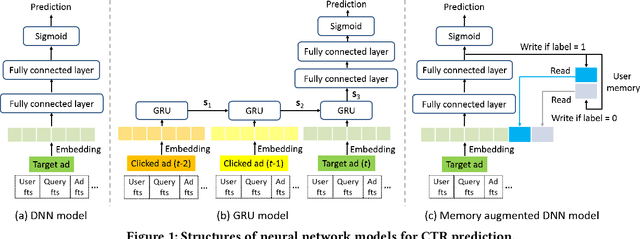


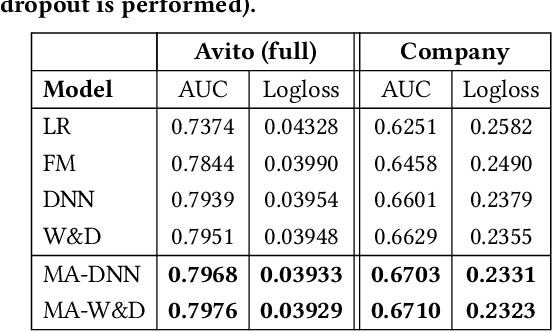
Abstract:Click-through rate (CTR) prediction is a critical task in online advertising systems. Models like Deep Neural Networks (DNNs) are simple but stateless. They consider each target ad independently and cannot directly extract useful information contained in users' historical ad impressions and clicks. In contrast, models like Recurrent Neural Networks (RNNs) are stateful but complex. They model temporal dependency between users' sequential behaviors and can achieve improved prediction performance than DNNs. However, both the offline training and online prediction process of RNNs are much more complex and time-consuming. In this paper, we propose Memory Augmented DNN (MA-DNN) for practical CTR prediction services. In particular, we create two external memory vectors for each user, memorizing high-level abstractions of what a user possibly likes and dislikes. The proposed MA-DNN achieves a good compromise between DNN and RNN. It is as simple as DNN, but has certain ability to exploit useful information contained in users' historical behaviors as RNN. Both offline and online experiments demonstrate the effectiveness of MA-DNN for practical CTR prediction services. Actually, the memory component can be augmented to other models as well (e.g., the Wide&Deep model).
Representation Learning-Assisted Click-Through Rate Prediction
Jul 19, 2019

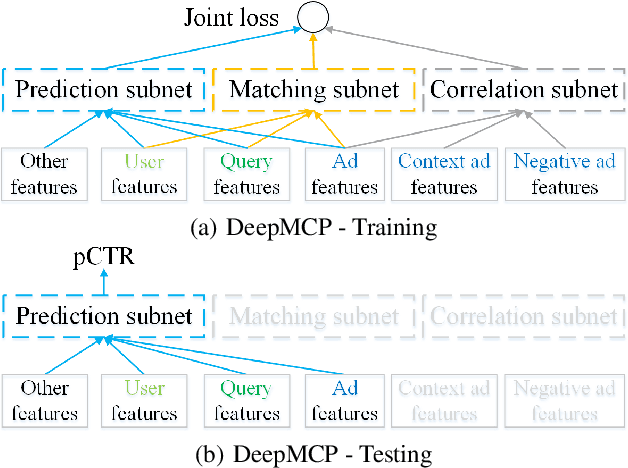

Abstract:Click-through rate (CTR) prediction is a critical task in online advertising systems. Most existing methods mainly model the feature-CTR relationship and suffer from the data sparsity issue. In this paper, we propose DeepMCP, which models other types of relationships in order to learn more informative and statistically reliable feature representations, and in consequence to improve the performance of CTR prediction. In particular, DeepMCP contains three parts: a matching subnet, a correlation subnet and a prediction subnet. These subnets model the user-ad, ad-ad and feature-CTR relationship respectively. When these subnets are jointly optimized under the supervision of the target labels, the learned feature representations have both good prediction powers and good representation abilities. Experiments on two large-scale datasets demonstrate that DeepMCP outperforms several state-of-the-art models for CTR prediction.
 Add to Chrome
Add to Chrome Add to Firefox
Add to Firefox Add to Edge
Add to Edge